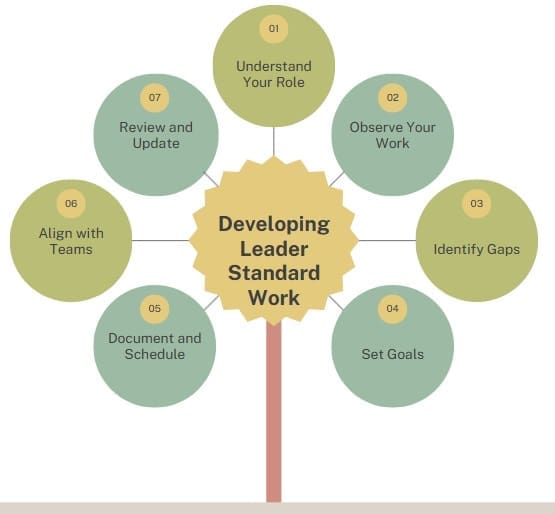Leader Standard Work (LSW) is a key part of Lean thinking. It’s not just a tool; it’s a mindset that shapes how leaders guide their teams, solve problems, and improve performance.
In essence, LSW defines what leaders do daily, weekly, and monthly to ensure their organizations run smoothly and continuously improve. It lays out both the “what” (timing, tasks, and results) and the “how” (coaching, accountability, and problem-solving).
In today’s dynamic workplace, especially in healthcare and research environments like Children’s Mercy Hospital, consistent leadership and operational excellence are essential. Leader Standard Work gives structure to leadership, enabling teams to deliver safe, reliable, and efficient services while creating a culture of learning and improvement.
Table of contents
Understanding Lean Thinking
Before we explore LSW, it’s important to understand Lean thinking—the foundation it’s built on. Lean is a philosophy focused on delivering value to the customer by eliminating waste and improving processes.
Lean organizations:
- Understand what the customer values most.
- Focus on streamlining processes that deliver that value.
- Strive for perfection by constantly identifying and removing waste.
- Aim for a perfect value stream—meaning every action adds value.
Further, lean management changes the way leaders think. Instead of managing isolated tasks or departments, leaders focus on improving how services flow across the entire organization. This horizontal approach connects teams and departments in service of a common goal: the customer.
Public, Onsite, Virtual, and Online Six Sigma Certification Training!
- We are accredited by the IASSC.
- Live Public Training at 52 Sites.
- Live Virtual Training.
- Onsite Training (at your organization).
- Interactive Online (self-paced) training,
What Is Leader Standard Work?
Leader Standard Work refers to the consistent actions leaders take to:
- Develop their people
- Improve processes
- Grow as leaders
It defines a routine—one that includes daily observations, meetings, coaching, problem-solving, and reflection. LSW helps leaders make their work visible and measurable so they can model the behaviors they expect from others.
Leader Standard Work Answers Two Key Questions:
- What do leaders do?
- Their schedules, tasks, meetings, and responsibilities.
- How do they do it?
- Through coaching, supporting, and driving accountability.
When applied well, LSW makes leadership deliberate rather than reactive. It ensures that leaders don’t just manage tasks, but lead with intention, always looking to improve their team and the processes they oversee.
Purpose of Standard Work
Standard Work is the most effective way to do a job. It’s the current best-known method to complete a task safely, efficiently, and with high quality. It’s not set in stone—it evolves as improvements are made.
Standard Work brings many benefits:
- Creates clarity around how tasks should be done.
- Increases consistency and reduces variability.
- Improves training by providing a repeatable process.
- Identifies when something is off-track (abnormal vs. normal).
- Sets a foundation for continuous improvement.
When leaders use Standard Work, they help ensure everyone knows what to do, how to do it, and what good performance looks like.
Components of Leader Standard Work
Let’s break down what Leader Standard Work involves on a daily, weekly, and monthly basis.
Daily Tasks
- Morning Planning: Leaders begin each day 15–30 minutes early to review goals, check schedules, and align with their teams.
- Standard Work Audits: Leaders review one operator per team to ensure they follow the agreed-upon process. This helps maintain quality and safety.
- Walks (Gemba Walks): Leaders observe work on the floor hourly. They look for downtime, obstacles, and deviations. These walks are about support—not blame.
- Mini-Business Meeting: Each day, teams meet on the floor to review performance, share concerns, and discuss improvements.
- Focus Area Reviews: Leaders choose one key issue (e.g., safety or quality) and discuss ideas for improvement with the team.
Weekly Tasks
- A3 Review: Leaders review problem-solving documents (A3s) to check if teams are thinking critically. They ask questions to challenge assumptions, not give answers.
- Team Problem Reviews: Leaders meet to reflect on problems and use data to prioritize which issues to solve first.
- Reflection: At the end of each week, leaders reflect on what happened, what was learned, and what needs to change.
Other Core Elements
- Coaching: Leaders teach problem-solving, listen to concerns, and help team members grow.
- Accountability: They hold people to agreed-upon standards and expectations.
- Improvement: Leaders always look for better ways to do the work and involve the team in testing ideas.
Also Read: What is Benchmarking?
Developing Leader Standard Work

Creating LSW starts with understanding your own responsibilities and routines. Here’s a step-by-step method to build your Leader Standard Work:
- Understand Your Role: Start with your job description and break it down into daily, weekly, and monthly activities.
- Observe Your Work: Track what you do each day. Notice how much time you spend solving problems versus developing your team.
- Identify Gaps: Compare what you do now with what you should be doing. Are you coaching enough? Are you doing too much firefighting?
- Set Goals: Create short- and long-term objectives for yourself and your team.
- Document and Schedule: Build a visual daily checklist of your activities. Include space for notes and reflections.
- Align with Teams: Make sure your LSW supports and connects with the Standard Work of your teams.
- Review and Update: LSW is a living document. Regularly improve it as you learn more.
Training and Support for Leader Standard Work
Many organizations support leaders through structured training programs. For example, at some hospitals or manufacturing settings, new supervisors attend a five-week training class that includes:
- Week 1: Introduction to Operational Excellence and leadership’s role as a coach.
- Week 2: Kaizen and how leaders support a culture of continuous improvement.
- Week 3: Problem-solving, first as a learner, then as a teacher.
- Week 4: Running your team like a mini-business, taking ownership of results.
- Week 5: On-the-job training with an experienced coach.
This kind of training helps leaders develop the habits needed to apply LSW effectively.
Making Standard Work Visual
Visual tools help make LSW practical and easy to follow. Some useful forms include:
- Standard Work Sheets: Show the steps of a task, who does what, and when.
- Gemba Boards: Public visual boards that show performance metrics, issues, and plans.
- Checklists: Help ensure that key tasks are not missed.
- Time Observation Forms: Break down tasks into timed steps to spot inefficiencies.
When processes are visual, it’s easier for leaders and teams to follow them and make improvements together.
Continuous Improvement Through Standard Work
LSW is not just about following a checklist. It’s about identifying problems, asking the right questions, and making small, consistent improvements. Leaders must:
- Never allow one bad hour to roll into the next.
- Help teams solve problems rather than take over.
- Document issues so they can be tracked and analyzed.
- Meet weekly to decide which problems to tackle using PDCA (Plan-Do-Check-Act).
When leaders model problem-solving and improvement, they create a culture where everyone feels responsible for making things better.
Also Read: What is Standard Work?
Why Leader Standard Work Matters?
LSW creates a ripple effect throughout the organization. When leaders follow a structured routine:
- Teams are more stable and productive.
- Quality and safety improve.
- Problems get addressed quickly.
- Team members feel supported and engaged.
- The organization becomes more agile and resilient.
Most importantly, LSW helps leaders build trust. It shows they’re committed, consistent, and always working to make things better—for their team and their customers.
Six Characteristics of Good Standard Work

Good LSW and Standard Work documents share six key traits:
- Current: Reflect the latest process.
- Complete: Include all essential steps and tasks.
- Clear: Use plain language everyone understands.
- Correct: Follow the right sequence.
- Concise: No filler words or unnecessary jargon.
- Communicated: Shared and accessible to all.
Standard Work must be living, not static. It evolves with feedback, improvements, and collaboration.
Final Words
Leader Standard Work isn’t a one-size-fits-all checklist. It’s a discipline that helps leaders stay focused, support their teams, and continuously improve how the work gets done. It brings structure without rigidity, clarity without control, and accountability without blame.
By defining and practicing LSW, leaders create a strong foundation for operational excellence. They help build a workplace where problems are opportunities, teams are empowered, and customers get the best possible service.
As you start applying LSW in your own role, remember: it’s not about being perfect. It’s about being intentional. Observe. Reflect. Ask questions. Coach. And improve—one day at a time

About Six Sigma Development Solutions, Inc.
Six Sigma Development Solutions, Inc. offers onsite, public, and virtual Lean Six Sigma certification training. We are an Accredited Training Organization by the IASSC (International Association of Six Sigma Certification). We offer Lean Six Sigma Green Belt, Black Belt, and Yellow Belt, as well as LEAN certifications.
Book a Call and Let us know how we can help meet your training needs.




















